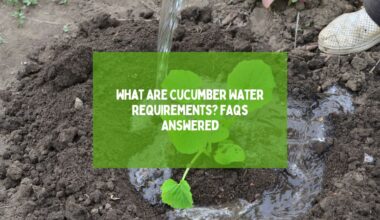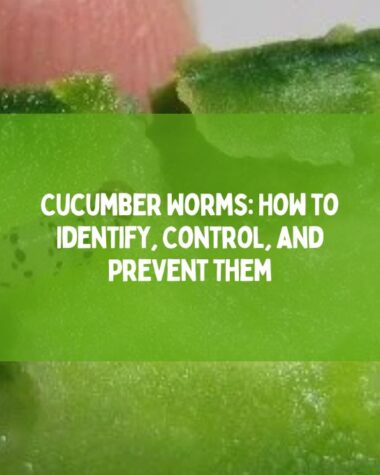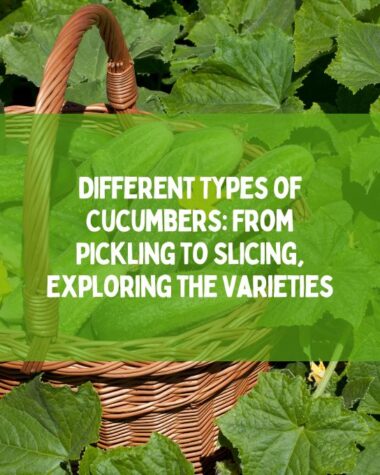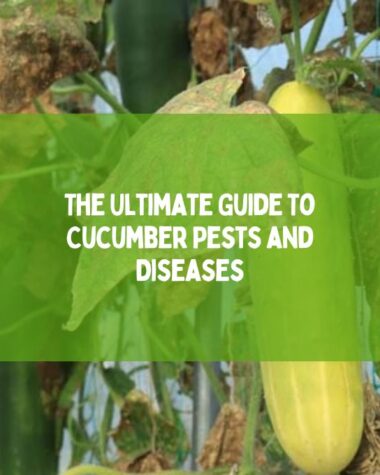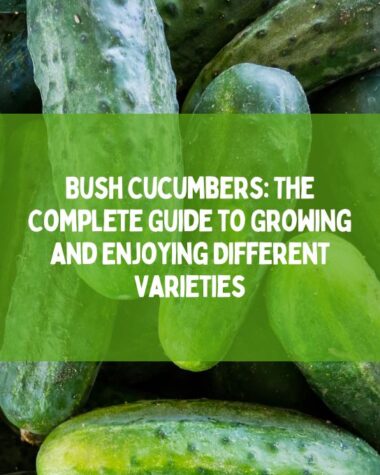Japanese cucumber is a type of cucumber with a thin skin and crunchy texture. It is low in calories and high in nutrients like vitamin C and potassium. It is commonly used in salads, sushi, and pickling.
Are you looking to add a unique flavor to your cucumber harvest? Japanese cucumbers, also known as ‘Kyuri’, are a great choice for any home gardener! With their sweet, crunchy texture and mild taste, they make a delicious addition to salads and sandwiches.
If you want to try growing your own Japanese cucumber plants, this guide will provide you with all the tips and tricks you need to get started. From choosing the right variety of seeds to proper planting techniques, you’ll find everything you need to know to successfully grow a cucumber plant from seed.
What is a Japanese cucumber?

Japanese cucumbers are a type of vine-grown cucumber that have forest green, dark green skin and slender bodies. They are shorter than an English cucumber but longer than a Persian cucumber.
Japanese cucumbers don’t contain developed seeds and are slightly sweet with no bitterness, making them great for pickling or eating raw. When planting Japanese cucumbers, choose from one of the many varieties available.
Japanese Cucumber Nutrition Information
| Serving Size | Calories | Fat | Carbohydrates | Protein |
| 1 piece | 15 kcal | 0.15g | 3.18g | 0.68g |
| 1 cup sliced | 16 kcal | N/A | N/A | N/A |
| 1 serving | 7 kcal | N/A | N/A | N/A |
| 100 g | 14 kcal | 0.1g | 2.8g | 0.6g |
These cucumbers grow best in well-draining, fertile soil in full sun. To give them extra support, provide a trellis or stake for the cucumbers to climb. For best results, mix in compost or potting soil and give the seedlings plenty of water.
How to Grow Japanese Cucumbers from Seeds?
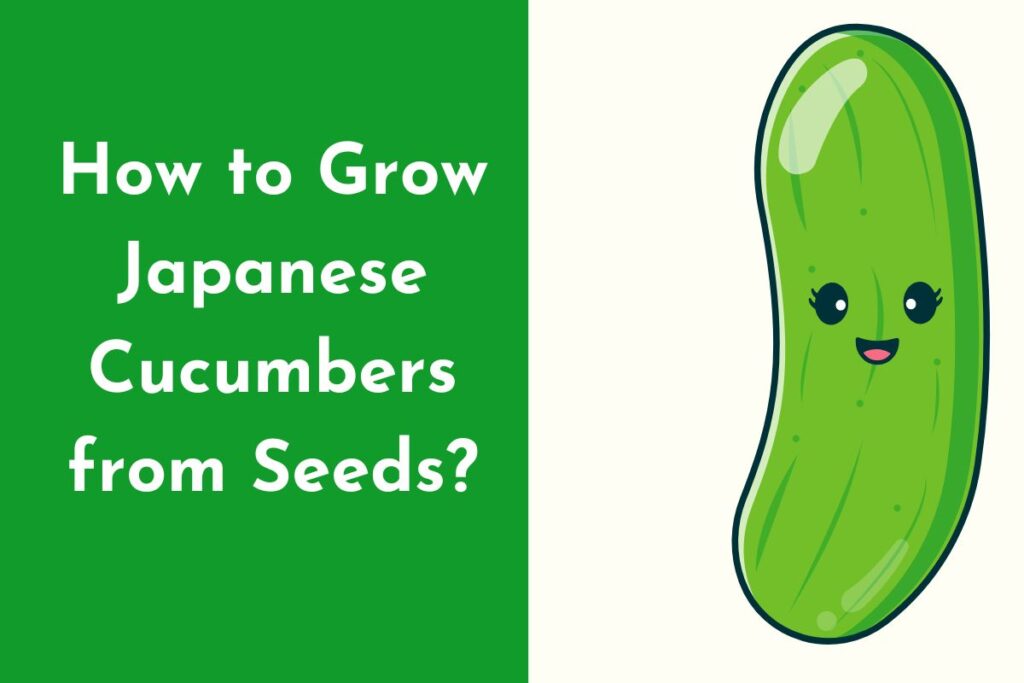
Japanese cucumbers are part of the Cucumis Sativus family and have many similarities to other cucumber varieties. Growing your own Japanese cucumbers can be a rewarding and cost-effective experience.
Japanese cucumbers are best grown outdoors in late spring or early summer. Temperatures between 70°F and 86°F (21°C and 30°C) are the best for growing these plants.
Here are step-by-step instructions for growing Japanese cucumbers.
Choose the Right Variety
When selecting a Japanese cucumber variety, it’s important to consider its female flower production, as well as its nutritional value. Japanese cucumbers are low in calories, so they make a great addition to any garden.
Japanese Cucumber Varieties
Here are some Japanese Cucumber varieties that you can grow.
- Kyoto
- Palace King
- Soarer
- Sooyow Nishiki
- Suhyo
- Tasty Green
- Tsuyataro
Additionally, some varieties are better suited for growing in specific climates and conditions, so make sure to choose one that fits your area best.
Find a suitable Location
When selecting a location for growing Japanese cucumbers, pick an area with at least 6 to 8 hours of full sun.
Soil preparation
Before planting Japanese cucumbers, it’s important to prepare the soil with the proper nutrients. Japanese cucumbers prefer a pH between 6.0 and 6.5 and they require a lot of nitrogen and other nutrients to produce high yields.
For best results, use well-draining soil enriched with organic matter. Add compost or manure to enrich the soil and add vital nutrients for healthy Japanese cucumber growth. Make sure to provide enough space for Japanese cucumbers to flourish.
Related Reading:
- What Are Cucumber Water Requirements? FAQs Answered
- Bush Cucumbers: The Complete Guide to Growing and Enjoying Different Varieties
- The Ultimate Guide to Growing Eggplant Seedlings: Planting and Caring Tips
Planting Japanese Cucumber Seeds

To get your Japanese cucumbers growing, plant the seeds 1 inch deep and 6-10 inches apart. Plant them in warm soil after all danger of frost has passed. Cover lightly with soil and water gently. Make sure to keep the soil moist for the best results.
Fertilizers and Watering
Japanese cucumbers also need fertilization for the best yields. If you want Japanese cucumbers to grow well, you should use a fertilizer that is high in potassium and phosphorus, but low in nitrogen. Use a fertilizer with a ratio of 3-6-6 to ensure even growth. Make sure not to over-fertilize, as too much can burn the plants.
Maintenance and Pest Prevention
- Keep the soil moist and weed-free.
- Mulch around the cucumber plant to prevent weeds.
- Check your plants often for signs of pests and diseases, and if you find any, treat them right away with natural solutions.
- Handpick any caterpillars or beetles you find.
What Are Japanese Cucumber Growth Stages?

Once the seeds have been planted and your cucumber plants have started to develop, there are several stages of growth they will go through before they produce fruit.
- Germination: The first stage is the germination stage. Japanese plant seed germination time is 7 to 10 days. During this period, the seed starts to sprout a tiny root and shoot above the soil. This usually takes anywhere from 1 to 4 weeks.
- Vegetative Growth: After the seed has germinated, the vegetative stage begins. During this period, the stem and leaves of the cucumber plant start to grow, reaching heights of around 18 to 30 inches. This stage typically lasts between 2 to 3 weeks.
- Flowering and Pollination: Once the Japanese cucumber plant has reached maturity, it will begin to produce flowers. Bees or other insects must pollinate the female flowers in order for fruit to form. If there are no pollinators in the area, you can help with hand pollination.
- Fruit Set and Ripening: After the cucumber flower has been pollinated, it will start to form fruit. During this time, the cucumber fruits will slowly increase in size until they reach their full size and ripen into a yellowish-green color. Depending on the variety, this process usually takes between 65 to 70 days.
- Harvesting: Once your cucumber fruits have ripened, it’s time to harvest them! Japanese cucumbers should be harvested while they are still young and tender, otherwise, they can become bitter. Once picked, the cucumbers should be eaten or stored within 1-2 days.
By understanding the different growth stages of Japanese cucumber plants, you’ll be able to better manage your plants and harvest your cucumbers at the perfect time!
How to Store and Preserve of Japanese Cucumbers?

Preserving and storing Japanese cucumbers is an easy and cost-effective way to enjoy their delicious flavor and crunchy texture year-round. There are several different ways to store and preserve Japanese cucumbers, depending on your preference.
Storing and Preservation Methods For Japanese Cucumbers
Here are some common and unique methods for storing Japanese cucumbers.
Store in a Cool & Dry Place
The most common way to store Japanese cucumbers is in a cool, dark place. For example, you can store them in the refrigerator for up to three weeks. You can also place them in a paper or plastic bag before storing them in the fridge.
Pickling
Pickling is another popular option for preserving Japanese cucumbers. You can use either salt or vinegar to pickle cucumbers, depending on your preference. This process will help preserve the cucumber’s crunch and flavor while also giving it a salty, acidic taste.
Fermenting
Fermenting is another way to store Japanese cucumbers. For the fermentation process to work, the cucumber must be submerged in a saltwater solution. This lets the cucumber’s natural sugars and bacteria make lactic acid. This helps to preserve the cucumber and give it a unique flavor.
Freezing
Freezing is also a great way to preserve Japanese cucumbers for later use. Simply slice the cucumber into pieces and place them in an airtight container or freezer bag. This will help keep the cucumber from losing its crunch and flavor over time.
No matter which Japanese cucumber storage method you choose, make sure to check the cucumber regularly for any signs of spoilage, such as wilting or mold growth. If you notice any of these signs, discard the cucumber right away.
Related Reading:
- Cucumber Worms: How to Identify, Control, and Prevent Them
- How To Grow Imperator Carrots?
- 26 Early Growing Tomato Varieties For Short Season
- When to Transplant Zucchini Seedlings? Let’s find out
FAQs
Here are some FAQs related to Japanese cucumber growth.
Are Japanese cucumbers self-pollinating?
Yes, Japanese cucumbers are self-pollinating. This means that they don’t require cross-pollination with other plants to form fruit. They have both male and female flowers on the same plant, and pollination occurs when the pollen from the male flower fertilizes the female flower.
Can Japanese cucumber be eaten raw?
Yes! Japanese cucumbers are a great snack that can be enjoyed raw. They have a crisp, juicy texture and mild, sweet flavor. They are also rich in essential vitamins and minerals such as Vitamin C, Vitamin K, potassium, and potassium.
What is the difference between English and Japanese cucumbers?
English cucumbers are longer, have smoother skin, and have fewer seeds than Japanese cucumbers. They have a milder flavor than Japanese cucumbers and are often sold wrapped in plastic or waxed.
Japanese cucumbers are shorter, have bumpier skin, and have more seeds than English cucumbers. They have a much stronger flavor and tend to be crunchier than English cucumbers. The amount of water content in Japanese cucumbers is also much higher than that of English cucumbers.
